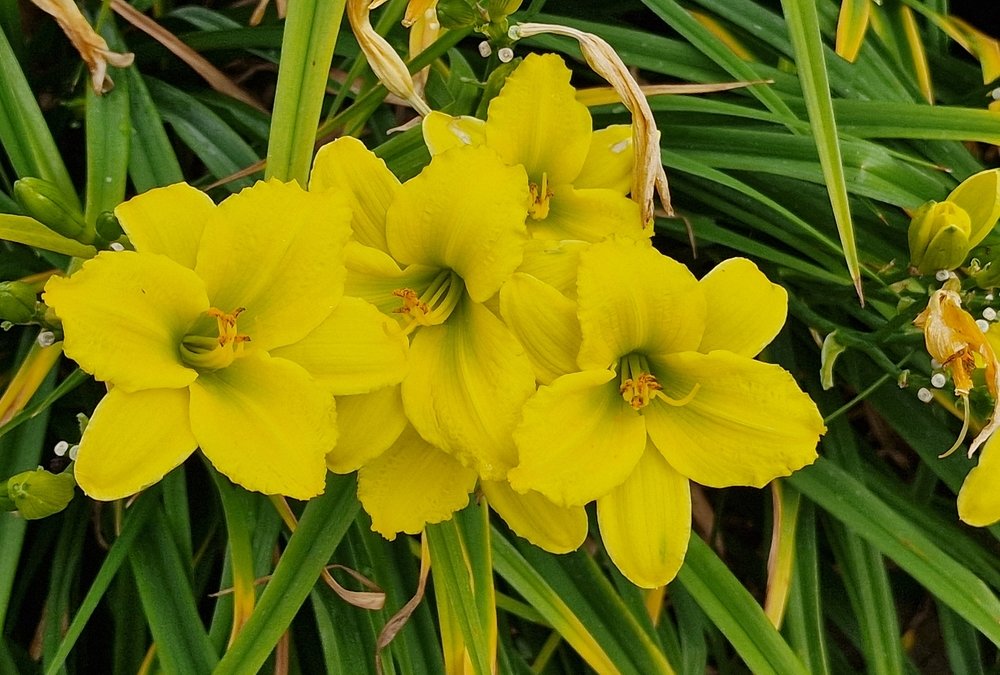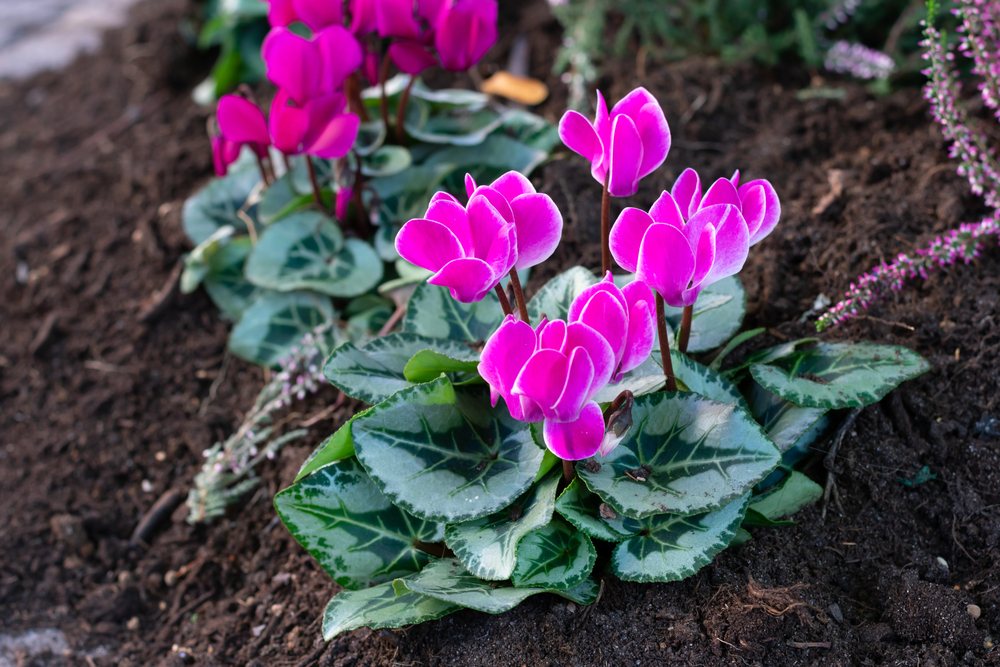
Daylilies are a popular choice among gardeners for their vibrant colors and relatively low maintenance needs.
These perennial flowers return year after year, bringing bursts of brightness to any garden.
To ensure their health and vigor, it’s essential to fertilize daylilies with the right nutrients at the right time.
This article offers useful tips on fertilizing daylilies to optimize their growth and beauty.
By understanding the specific needs of these resilient flowers, you can enhance their floriferous blooms and keep them looking their best throughout the season.
So, whether you’re an experienced gardener or a newcomer to the world of daylilies, these suggestions will help you create a thriving and captivating garden display.
Understanding Daylily Fertilization Needs
Daylilies are a popular, low-maintenance perennial plant known for their colorful blooms and hardiness. To ensure the healthiest growth and beautiful blooms, it’s essential to provide them with the proper fertilization. Here’s a friendly guide to understanding the fertilization needs of daylilies.

First, it’s crucial to know what nutrients your daylilies require. Like most plants, they need three primary nutrients: nitrogen (N), phosphorus (P), and potassium (K). Nitrogen promotes healthy foliage growth, phosphorus helps with root development and blooming, and potassium supports overall plant health and vigor.
When selecting a fertilizer, look for one with a balanced N-P-K ratio, such as 10-10-10 or 14-14-14. These numbers indicate the percentage of each nutrient, with the first being nitrogen, the second phosphorus, and the third potassium. Using a balanced fertilizer ensures your daylilies receive the appropriate nutrients at an optimal ratio for growth.
Fertilization frequency for daylilies should be moderate. Over-fertilizing can lead to excessive growth and weaken the plant, potentially leaving it more susceptible to diseases or pests. As a general rule, apply a balanced fertilizer in the spring, as new growth begins, and again in mid-summer to help support the plant throughout the growing season.
Keep in mind the importance of soil testing. The soil’s pH and nutrient levels play a significant role in your plants’ overall health. Daylilies prefer a slightly acidic to neutral soil pH of around 6.0 to 7.0. If you’re unsure about your soil’s pH or nutrient levels, consider doing a soil test. Knowing your soil’s exact nutrient content can help you customize your fertilization routine and avoid nutrient deficiencies or toxicities.
Choosing the Right Fertilizer
When it comes to fertilizing daylilies, choosing the right fertilizer can make all the difference in the health and growth of your plants. In this section, we’ll discuss the pros and cons of organic and synthetic fertilizers, as well as the importance of NPK ratios.

Organic vs Synthetic Fertilizers
Organic fertilizers are derived from natural sources, such as compost, manure, and bone meal. They release nutrients slowly, helping to build up the soil’s fertility over time. Some benefits of using organic fertilizers for your daylilies include:
- Improved soil structure and water retention
- Encouragement of beneficial microbes
- Reduced risk of nutrient runoff and pollution
However, organic fertilizers may take longer to show results and can be more expensive than synthetic options.
Synthetic fertilizers, on the other hand, are chemically manufactured and provide nutrients to plants more quickly. Advantages of using synthetic fertilizers include:
- Fast-acting results with more predictable outcomes
- Often more affordable and readily available
- Precise control over nutrient levels
Despite these benefits, synthetic fertilizers can cause nutrient buildup and may harm the soil’s natural ecosystem if not used carefully.
NPK Ratios
The NPK ratio refers to the proportion of nitrogen (N), phosphorus (P), and potassium (K) present in a fertilizer. These nutrients are essential for proper plant growth and development. For daylilies, an ideal NPK ratio is around 10-10-10 or 14-14-14. This balanced ratio provides adequate nutrients to support strong growth, vibrant blooms, and overall plant health.
When choosing a fertilizer for your daylilies, pay attention to the listed NPK ratio on the label and select one that aligns with the recommended values. Remember that both organic and synthetic fertilizers can provide the necessary nutrients, so consider the benefits and drawbacks of each when making your decision.
In conclusion, to ensure the best results when fertilizing your daylilies, opt for a fertilizer that offers the appropriate NPK ratio and consider whether an organic or synthetic option best suits your needs.
When to Fertilize Daylilies
Seasonal Timing
Fertilizing daylilies at the right time is essential for encouraging optimum growth and blooming. The best time to fertilize these plants is in the early spring, just as they begin to produce new growth. This timing helps provide the necessary nutrients for the plants to develop strong roots, foliage, and blooms.
If you have evergreen daylilies, you can continue fertilizing throughout the summer. In regions with mild winters, fertilize every 6 to 8 weeks during the growing season to support the daylilies’ continuous growth. In colder climates, consider stopping fertilization by late summer to allow the plants to prepare for dormancy naturally.
When it comes to choosing a fertilizer, a balanced formula like 10-10-10 or 14-14-14 is ideal. These numbers indicate the percentage of nitrogen (N), phosphorus (P), and potassium (K), respectively. Nitrogen promotes lush green foliage, while phosphorus helps with root growth and potassium enhances flower production.
Here are some key points to remember:
- Fertilize in early spring as new growth appears
- Evergreen daylilies can be fertilized throughout the summer
- In colder climates, stop fertilizing by late summer
- Use a balanced fertilizer with equal amounts of N, P, and K
Following these guidelines will help you provide the necessary nutrients for your daylilies to grow strong and produce bountiful blooms. Remember to always follow the manufacturer’s instructions for proper fertilizer application rates and methods to ensure the best results for your plants.

How to Apply Fertilizer
When it comes to fertilizing daylilies, there are different methods you can use to apply the fertilizer to your plants. In this section, we’ll explore three different ways, which are Soil Incorporation, Top Dressing, and Liquid Application.
Soil Incorporation
Soil incorporation is the process of mixing fertilizer directly into the soil before planting daylilies. This method ensures that the nutrients are evenly distributed throughout the growing area, providing a strong foundation for the plants to grow. To do this:
- Measure the area where you’ll be planting daylilies and determine the amount of fertilizer needed based on the product’s label recommendations.
- Start by loosening the soil to a depth of about 8-10 inches, using a garden fork or tiller.
- Apply the fertilizer evenly to the soil surface, following the recommended application rate.
- Mix the fertilizer into the soil thoroughly, making sure it is evenly distributed throughout the planting area.
Top Dressing
Top dressing is the application of fertilizer to the soil surface, allowing it to slowly work its way into the soil. This method is great for established daylilies that need an extra boost of nutrients. Here’s how you can do top dressing:
- Choose a granular fertilizer specifically formulated for daylilies, paying attention to the N-P-K ratio.
- Distribute the fertilizer evenly around the base of your daylilies, avoiding contact with the plants themselves.
- Lightly scratch the fertilizer into the top layer of the soil to help it blend and prevent runoff during watering.
- Water the area well to help the fertilizer dissolve and reach the root zone of the plants.
Liquid Application
Liquid fertilizers are a fast-acting option that can provide your daylilies with a quick nutrient boost. They are typically applied with a watering can or through a fertigation system. Follow these steps for successful liquid application:
- Select a liquid fertilizer suitable for daylilies, following the manufacturer’s instructions for mixing and application rates.
- Fill a watering can with the appropriate amount of water and fertilizer mix.
- Apply the fertilizer solution evenly over the root zone of your daylilies, wetting the soil thoroughly to distribute the nutrients effectively.
- Repeat the application as needed throughout the growing season, following the manufacturer’s recommendations.
By using one of these methods—Soil Incorporation, Top Dressing, or Liquid Application—you can ensure that your daylilies receive the nutrients they need to grow and thrive. Choose the method that best fits your garden and growing preferences, and remember to follow all fertilizer instructions carefully for the best results.

Watering After Fertilization
Proper watering is essential after fertilizing your daylily plants. This friendly reminder will help you ensure that your daylilies receive the correct amount of water and that the nutrients from the fertilizer are adequately absorbed.
One important tip is to water your daylilies thoroughly on the day you apply the fertilizer. By doing this, you help the fertilizer to dissolve and move down into the soil, allowing the nutrients to become available to the plant roots. This process is essential for the daylilies to truly benefit from the fertilizer.
Keep an eye on the soil moisture after fertilizing—it should be consistently moist but not soggy. Daylilies prefer well-draining soil, so it’s crucial to make sure the soil doesn’t become waterlogged. Overwatering can lead to root rot and other fungal diseases that may harm your plants.
Additionally, consider the weather conditions when planning your watering schedule. If your region experiences frequent rain or has particularly humid conditions, you may need to adjust your watering routine accordingly. Conversely, during hot or dry spells, daylilies may need more frequent watering to maintain the proper soil moisture level.
Here are some general watering guidelines for daylilies after fertilization:
- Water deeply on the day of fertilization.
- Check the soil moisture daily and adjust the watering schedule as needed.
- Aim for consistently moist soil, but avoid waterlogged conditions.
- Consider weather conditions and adjust watering frequency accordingly.
By paying attention to these friendly watering tips, you’ll help your daylilies effectively absorb the nutrients from the fertilizer, promoting healthy growth and beautiful blooms!

Monitoring Your Daylilies’ Health
Keeping an eye on your daylilies’ health is vital for maintaining their growth and ensuring they receive proper fertilization. It’s essential to regularly check for potential issues and take the appropriate steps to address them.
Observe the leaves of your daylilies for any signs of discoloration or wilting. Yellowing leaves can indicate a lack of nutrients, while wilted leaves might suggest over-watering or under-watering. Adjust your watering schedule accordingly to maintain the right balance.
Pests can also be a concern for daylilies. Look for signs of bugs, such as holes in the leaves, and remedy the situation using natural pest control methods, like introducing beneficial insects, or employing organic pesticides if needed.
Furthermore, keep track of your daylilies’ growth rate. If they seem to be struggling to develop, consider adjusting the fertilizer application or changing the type of fertilizer used. Ensure that the chosen fertilizer contains the necessary nutrients, like nitrogen, phosphorus, and potassium, in the right proportions for optimal growth.
Lastly, it’s crucial to monitor the soil’s pH levels near your daylilies. A pH level between 6 and 7 is ideal for these plants. If the pH level is too high or too low, you can amend the soil with lime or sulfur to achieve the proper balance.
By keeping a close eye on your daylilies’ wellbeing and making adjustments as needed, you can help ensure their healthy growth and promote beautiful blooms.













